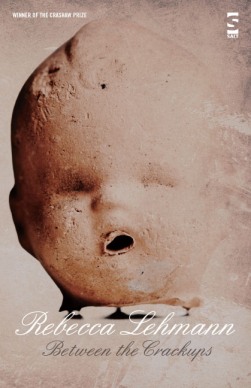Book Review
Rebecca Lehmann, Between the Crackups, Salt Publishing, 2011
by Morgan Harlow
“All rather inhuman and undernourished, isn’t it? Well, that, children, is the true sign of cracking up.” F. Scott Fitzgerald, “The Crack-up,” (1936, Esquire)
With a title recalling Virginia Woolf’s Between the Acts and suggestive of periods of mental instability that marked the careers of many important modernist literary figures, Rebecca Lehmann’s debut collection plays off of the linear view of history that has traditionally dominated Western thinking. The notion of a steady progression of events through time has provided raison d’être for many an institution and industrial growth, with emphasis on movement from one peak to the next rather than on the spaces in between. In a truly linear world the flat space, the ‘between’ of Between the Crackups, is inconsequential to the already determined peaks, in this case the ‘crackups,’ and therefore Between the Crackups would be called simply The Crackups. Similarly, Between the Acts, a metaphor for the period of time between the two world wars, would become The Acts. Modern technology has facilitated swift succession from one peak to the next, and, tragically, from one war to the next until all becomes peak production, war and gearing up for war. The in between time of peace no longer exists and becomes mere illusion, a placeholder between the wars, and between the crackups.
Between the Crackups abandons this Western view of the inevitability of linearity and instead evokes chaos and the randomness and disorder of experience:
Origins have no location in this history:
a story of who did what, and when, and why.
The impetus could be orange blossoms, or cockatiels,
Or a short story set in Texas; it doesn’t matter.
All we have are fragments—the aluminum(‘The History of Yesterday’)
Surprising and decisive clarity, as in the poem ‘The Devil is in Detroit’—“Between the crackups, a light came / strong enough to cut the blight”—announces the ‘between’ not as a time of passivity but of awe and potential change. It is a revelation contrary to expectations grown out from a poem in which the speaker, in the manner of a detached witness yet self-identified as involved with the ‘you’ addressed in the poem, describes details of their intimate relationship.
Here and in poems throughout the book, the use of “I,” “we” and the addressed “you” is a disarranged mix of endearments, confidences, fears, horrors and pervading sadness. References to veils, boots, mouth, teeth, heart, feet and other body parts appear and recur, as well as allusions to failed expectations and failing others, insults and abuse, thoughts and lives cut off, fragments and non sequiturs that ultimately cohere to make a spontaneous and uncensored response to a nightmarish world that holds convincing parallels to our own world. Lehmann’s poems offer a powerful dystopian critique of civilization gone awry, from a viewpoint “between the crackups.”
Morgan Harlow’s poems, fiction, and other writing have appeared in Seneca Review, The Tusculum Review, The Moth, E·ratio, Leveler, and elsewhere. Her debut poetry collection, Midwest Ritual Burning, is published by Eyewear Publishing.


